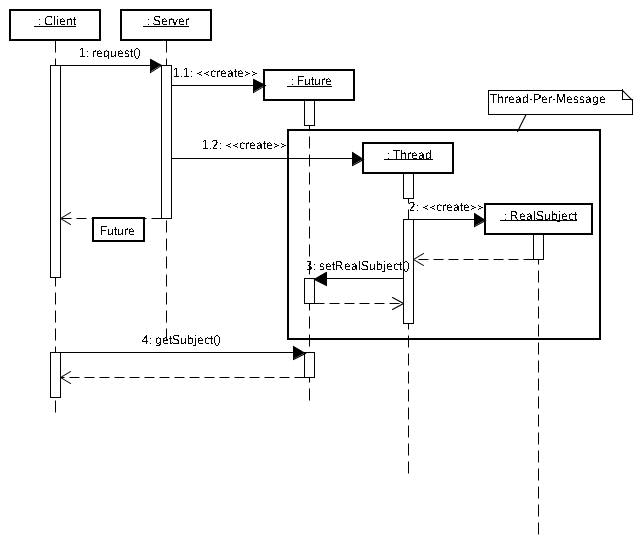接着上一篇继续并发包的学习,本篇说明的是Callable和Future,它俩很有意思的,一个产生结果,一个拿到结果。
Callable接口类似于Runnable,从名字就可以看出来了,但是Runnable不会返回结果,并且无法抛出返回结果的异常,而Callable功能更强大一些,被线程执行后,可以返回值,这个返回值可以被Future拿到,也就是说,Future可以拿到异步执行任务的返回值,下面来看一个简单的例子:
public static void main(String[] args) {
Callable<Integer> callable = () -> {
return new Random().nextInt(100);
};
FutureTask<Integer> futureTask=new FutureTask<Integer>(callable);
new Thread(futureTask).start();
try{
Thread.sleep(500);
System.out.println(futureTask.get());
}catch (Exception e){
e.printStackTrace();
}
}
Future模式介绍:

FutureTask实现了两个接口,Runnable和Future,所以它既可以作为Runnable被线程执行,又可以作为Future得到Callable的返回值,那么这个组合的使用有什么好处呢?假设有一个很耗时的返回值需要计算,并且这个返回值不是立刻需要的话,那么就可以使用这个组合,用另一个线程去计算返回值,而当前线程在使用这个返回值之前可以做其它的操作,等到需要这个返回值时,再通过Future得到,岂不美哉!这里有一个Future模式的介绍:http://openhome.cc/Gossip/DesignPattern/FuturePattern.htm。
下面来看另一种方式使用Callable和Future,通过ExecutorService的submit方法执行Callable,并返回Future,代码如下:
public class CallableAndFuture {
public static void main(String[] args) {
ExecutorService threadPool = Executors.newSingleThreadExecutor();
Future<Integer> future = threadPool.submit(new Callable<Integer>() {
public Integer call() throws Exception {
return new Random().nextInt(100);
}
});
try {
Thread.sleep(5000);// 可能做一些事情
System.out.println(future.get());
} catch (InterruptedException e) {
e.printStackTrace();
} catch (ExecutionException e) {
e.printStackTrace();
}
}
} 代码是不是简化了很多,ExecutorService继承自Executor,它的目的是为我们管理Thread对象,从而简化并发编程,Executor使我们无需显示的去管理线程的生命周期,是JDK 5之后启动任务的首选方式。
执行多个带返回值的任务,并取得多个返回值,代码如下:
public class CallableAndFuture {
public static void main(String[] args) {
ExecutorService threadPool = Executors.newCachedThreadPool();
CompletionService<Integer> cs = new ExecutorCompletionService<Integer>(threadPool);
for(int i = 1; i < 5; i++) {
final int taskID = i;
cs.submit(new Callable<Integer>() {
public Integer call() throws Exception {
return taskID;
}
});
}
// 可能做一些事情
for(int i = 1; i < 5; i++) {
try {
System.out.println(cs.take().get());
} catch (InterruptedException e) {
e.printStackTrace();
} catch (ExecutionException e) {
e.printStackTrace();
}
}
}
} 其实也可以不使用CompletionService,可以先创建一个装Future类型的集合,用Executor提交的任务返回值添加到集合中,最后遍历集合取出数据,代码略。更新于2016-02-05,评论中就这个说法引发了讨论,其实是我没有讲清楚,抱歉。这里再阐述一下:提交到CompletionService中的Future是按照完成的顺序排列的,这种做法中Future是按照添加的顺序排列的。所以这两种方式的区别就像评论中fishjam所描述的那样。
本文来自:高爽|Coder,原文地址:http://blog.csdn.net/ghsau/article/details/7451464,转载请注明。